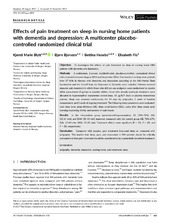Effects of pain treatment on sleep in nursing home patients with dementia and depression: A multicenter placebo-controlled randomized clinical trial
Peer reviewed, Journal article
Published version

Åpne
Permanent lenke
https://hdl.handle.net/1956/21424Utgivelsesdato
2018-12-28Metadata
Vis full innførselSamlinger
Originalversjon
International Journal of Geriatric Psychiatry. 2018, 33 (4), 663-670. https://doi.org/10.1002/gps.4839Sammendrag
Objective: To investigate the effects of pain treatment on sleep in nursing home (NH) patients with dementia and depression. Methods: A multicenter, 2‐armed, double‐blinded, placebo‐controlled, randomized clinical trial conducted between August 2014 and September 2016. One hundred six long‐term patients from 47 NHs in Norway with dementia and depression according to the Mini‐Mental State Examination and the Cornell Scale for Depression in Dementia were included. Patients received stepwise pain treatment in which those who did not use analgesics were randomized to receive either paracetamol (3 g/day) or placebo tablets; those who already used pain treatment were allocated to buprenorphine transdermal system (max. 10 μg/h/7 days) or placebo transdermal patches. Sleep was assessed continuously for 14 days by actigraphy, 1 week of baseline measurement, and 1 week of ongoing treatment. The following sleep parameters were evaluated: total sleep time, sleep efficiency (SE), sleep onset latency (SOL), wake after sleep onset, early morning awakening (EMA), and number of wake bouts. Results: In the intervention group (paracetamol/buprenorphine), SE (70%‐72%), SOL (32‐24 min), and EMA (50‐40 min) improved compared with the control group (SE, 70%‐67%; SOL, 47‐60 min; EMA, 31‐35 min). Treatment effects were significant (P < .01, P < .05, and P < .05, respectively). Conclusion: Compared with placebo, pain treatment improved sleep as measured with actigraphy. This implies that sleep, pain, and depression in NH patients should be critically evaluated and that pain treatment should be considered to be a potentially beneficial treatment.
